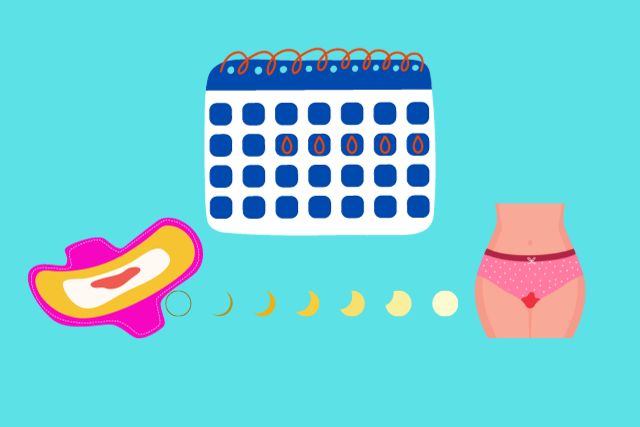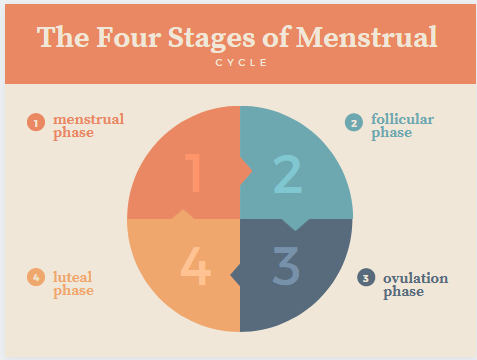Discover the menstrual cycle phases that effect every woman and unlock the power to deal with every problem associated with every phase improve overall comfort during that time of the month. Explore our guide to the best natural remedies and have a clue when you need to see a professional!
Menstruation is a sign of puberty in women. While it may occur as early as eight years, others begin to experience a steady monthly flow from 15 years.
The menstrual cycle phases entail the shading of the uterus wall which occurs due to failed implantation and subsequent hormonal changes that regulate a woman’s body. Within this monthly cycle, the ovaries release a mature egg ready for fertilization. Consequently, the uterus lining builds up in preparation for nurturing a fertilized egg. If egg fertilization and pregnancy doesn’t happen, the uterine lining sheds off in what we term as menstruation. Then the cycle starts again.
For me,
Growing as a teenager in rural areas was quite challenging. It was taboo for adults to talk about menstruation in black and white.
Girls were left to learn through experience. Hence, we juggled between understanding what was happening and managing some of the unpleasant symptoms.
But that’s all in the past.
In this article, I’m going to explain;
- The four stages of the menstrual cycle
- The Common menstrual problems
- The leading causes of menstrual problems
- And, when to see the doctor
When Does Menstruation Begin?
The menstruation periods begin between the ages of 8 and 15 years. Often, most women will experience a steady flow between the ages of 11 and 15 years.
Averagely, the cycle length runs between 28 to 29 days. But others may have a cycle length of 21 days as it varies between women and from one cycle to another.
Your menstrual cycle length begins from the first day of your period. And run till the day before the start of your next period.
The Four Stages of the Menstrual Cycle
There are four phases of the menstrual cycle;
- Menstruation phase
- Follicular phase
- Ovulation phase
- Luteal phase
1. The Menstruation Menstrual Cycle Phases
This is the first phase in your menstrual cycle. It’s characterized by the shading of the uterus lining, accompanied by virginal bleeding in what we refer to as periods.
During this phase, your reproductive system has an unfertilized egg from the previous cycle. The unfertilized egg will not lead to pregnancy, hence causes a decrease in the estrogen and progesterone sex hormones.
But remember;
The uterus had prepared to support pregnancy. And since there is no pregnancy, the thickened uterus lining (endometrium) is no longer needed.
It thus sheds and comes out through the Yoni. Releasing, a combination of blood, mucus, and tissues.
The average length of this phase is between three to seven days.
What are the symptoms of menstruation?
The menstruation symptoms include:
- Abdominal cramping. This occurs due to uterine contractions that help shed the inner lining of the uterus (endometrium) when a pregnancy doesn’t happen.
- A feeling of tenderness in your breasts
- Occasional mood swings and irritability due to hormonal changes
- Lower back pain
- Headaches and mild sneezing
- General body fatigue
- Bloating
- Loss of appetite or food cravings
- Facial breakout. Your face may get some pimples due to natural hormonal changes associated with the female reproductive cycle.
Estrogen and progesterone levels decline during your periods. While androgen hormones, such as testosterone, increase. These androgens hormones stimulate the production of sebum, an oil produced by the skin’s sebaceous glands.
When the production of sebum is too much, you may experience pimple breakouts. But, they will disappear as soon as you’re done with your periods.
Related:16 Simple Home Remedies for Period Cramps that Actually Work
2. Follicular Menstrual Cycle Phases
The follicular phase begins on the first day of your period and ends during ovulation.
During this phase, the hypothalamus signals your pituitary gland to release follicle stimulation hormone (FSH).
This (FSH) hormone stimulates your ovary to produce follicles, the tiny sacs containing immature eggs. Your ovaries can produce 5 to 20 follicles on average, but only the healthiest egg will mature.
Sometimes, a woman may have two eggs mature, which results in twins. But, the rest of the follicles disintegrates into your body.
The maturing follicle stimulates the production of estrogen, which thickens the lining of your uterus. This creates a nutrient-rich environment for embryonic growth in case of pregnancy.
The follicular phase may last for about 16 days but may also vary with different menstrual cycle lengths.
3. The ovulation Menstrual Cycle Phases
Ovulation is the process by which your ovary releases a mature egg. This happens around the 14th of the 28- day menstrual cycle.
Worth noting is that this is the only time a woman has a high chance of getting pregnant.
Whichever the length of your cycle, your ovulation day may occur in the four days before or after the cycle’s midpoint.
How does ovulation happen?
The ovulation process begins between days 6 and 14 of the menstrual cycle. Your body releases follicle-stimulating hormones, which help the eggs in the ovaries to mature. Maturity is necessary for fertilization in the uterus.
Upon egg maturity, your body releases or may increase luteinizing hormone (LH).
The surge in LH hormone prompts the ovaries to release the egg, which travels through the fallopian tubes to the uterus.
When the ovary releases the egg, it may or may not get fertilized by sperm. If fertilized, the egg travels to the uterus and implants to develop into a pregnancy.
If left unfertilized, the egg disintegrates, and the uterine lining is shed during your period.
This whole process only takes 24 hours, and the egg may die afterward if not fertilized.
Understanding the ovulation process is crucial if you are thinking of getting or preventing pregnancy. Also, note that sperm can live up to five days; hence you can become pregnant by having sex five days prior to ovulation.
Ovulation symptoms
These symptoms may vary from one woman to another, and they include;
- Increase in clear and stretchy virginal discharge.
- Some spotting
- Increase in breast tenderness
- A rise in body temperature
- Increase in sexual urge
- Abdominal pain or discomfort.
4. Luteal Menstrual Cycle Phases
The luteal phase involves the change of the follicle into the corpus luteum. This changes begin to happen immediately after the folic release of the egg in ovulation.
The corpus luteal begins to release progesterone and estrogen hormones. These hormones thicken the uterine lining in readiness for the implantation of a fertilized egg.
In case of pregnancy, your reproductive system will produce human chorionic gonadotropin (HCG). This is the hormone that maintains the corpus luteal for a thick uterine lining. It’s also what is detected in pregnancy tests.
In case the pregnancy doesn’t occur, the estrogen and progesterone hormonal levels will decrease. This decrease will then cause the shrinking of the corpus luteal and eventually the shedding of the uterine lining in what we term as periods.
The withering and reabsorption of the corpus luteal happen within 22 days in a 28-day cycle. The process repeats itself monthly till you reach menopause.
The premenstrual syndrome (PMS) that occurs in the luteal phase can cause
- A feeling of breast tenderness
- Mild headaches
- Changes in your mood
- Changes in sexual drive
- Change in appetite
Common Menstrual Problems
Some of the common menstrual problems include:
1. Menstrual pains (dysmenorrhea).
Getting pains during menstruation is common for many women. These pains can vary from severe cramps to mild abdominal heaviness. There are two types of dysmenorrhea:
- Primary dysmenorrhea. This is common to many women, and the pain is manageable. This pain comes due to uterus contractions as it clears the chick lining
- Secondary dysmenorrhea. This is not common, and the pain is generally severe. This pain occurs due to other health problems such as endometriosis, uterine fibroids, and ovarian cysts.
2. Irregular periods
Irregular periods consist of short periods or even longer cycles than the average. This means your menstrual cycle is less than 24 days or more than 38 days respectively.
Also, your cycle length varies by more than 20 days from month to month, meaning the length is very unpredictable.
This type of abnormality happens mostly in teenage girls who are just beginning to menstruate and perimenopause women.
3. Heavy bleeding
Averagely, you should lose between 5 mL to 80 mL of fluid flow per period. Going beyond 80 mL may be considered abnormal.
This is especially true if you need to change your pad after less than 2 hours or notice sizeable blood clots in your flow.
Prolonged heavy bleeding can lead to anemia. You should, thus, seek medical attention quickly.
4. Menstrual migraine
Migraine usually causes excruciating, severe headaches. While various factors can trigger a migraine, recent studies show that about four in 10 women report having migraines around their menstruation period.
Researchers have thus, concluded that some hormones which control the menstrual cycle might affect headache-related chemicals in the brain, causing menstrual migraine.
5. Missing periods (amenorrhea)
The primary sign of amenorrhea is the lack of regular periods. Studies show that this condition happens in 3% to 4% of women.
With amenorrhea, one might miss periods for as long as three months or more. And, this happens without any reasonable causes, such as pregnancy or breastfeeding.
Also, if you’re past the age of 15 years without your fast flow, you may consider checking out for this condition.
The cause of amenorrhea condition is the law production of estrogen hormone by the ovary. Lack of this hormone can have severe effects on your health.
What Causes Menstrual Problems?
There are many causes of menstrual problems. From hormonal issues to mental conditions such as stress and even some illnesses. The common ones include;
- Thyroid problems. This occurs when you have hyperthyroidism or hypothyroidism. This means you have over or underproduction of thyroid hormone.
When your thyroid doesn’t function properly, it impacts your reproductive hormones. This condition can cause menstrual issues.
The symptoms include; enlargement of the thyroid gland, irregular menstrual periods, heavy menstrual periods, hoarse voice, and forgetfulness.
- High prolactin levels in the blood. Excess prolactin causes breast milk production in men and women. This can happen even without pregnancy or breastfeeding.
Since it’s a hormone that regulates essential functions in the reproductive system, too much prolactin can also cause menstrual problems.
- Prolonged use of certain medicines, such as those for epilepsy or anxiety
- Polycystic ovary syndrome (PCOS). A condition that usually causes multiple ovarian cysts, hormonal imbalance, and irregular periods.
- Pelvic inflammatory disease. This is an infection of the reproductive organs, often caused by a sexually transmitted infection (STI).
The bacteria can spread from the vagina to the uterus and ovaries. Symptoms may include fever, vaginal discharge, and pelvic pains.
If left untreated can cause menstrual problems.
- Stress and anxiety. Prolonged stress can lead to depression and other mental illnesses, which can cause irregular periods. This is because it sets your body into a fighting mood and stimulates the cortisol hormone. This hormone can adversely affect your reproductive balance leading to delayed menstruation.
- Uncontrolled diabetic condition. Having diabetes puts you at the risk of having irregular menses. Type 1 and type 2 diabetes can affect your ovulation. If you have this condition, ensure you get it under control by taking medicines prescribed by your doctor.
- Problems with the uterine lining. Some women may have a thin uterine lining. This results from poor nutrition, poor uterine blood flow, or structural issues such as uterine fibroids, a septum, or scar tissue.
The main symptoms include painful and scanty periods. Sometimes, you may notice clots in menstrual blood or a change of color to dark red or purple.
When Should You Consider Visiting a Doctor?
During the menstrual cycle, many hormonal changes occur inside the body. These changes affect our moods and our general well-being.
While we can manage some discomforts, there are those problems that persist and hence, need special attention. Here is a checklist that may prompt you to seek medical interventions.
- You have not gotten your period by the age of 15 years. Or, you haven’t started menstruation within three years after your breast growth began.
- Your period lasts longer than eight days with heavy bleeding.
- You have sizeable menstrual blood clots
- You feel dizzy, weak, tired, and lightheaded. Or if you usually have chest pain that causes difficulty in breathing.
- You have gone three months without a period, and you’re not pregnant or breastfeeding.
- You experience severe headaches with aura – occasional seeing bright flashing lights.
- You swell in the thyroid glands or have become very forgetful
These may be a sign of an underlying problem. Seeking help early enough can help in salvaging your health.
Takeaway
Each woman’s menstrual experience is different. Sometimes you may feel normal, while another time is a total discomfort. It’s thus essential that you familiarize yourself with your cycle to point out any anomalies and seek medical interventions.
What is your experience? Have you encountered any pains? Kindly let’s share our menstrual ordeals and possible remedies that keep us going in the comment below so that we can encourage those who are beginning.
It’s always a pleasure to hear from you!
DISCLAIMER The information contained in this post is for general information purposes only. I’m not a health practitioner and as such, this information should not be used as a substitute for consultation with your professional service provider.





